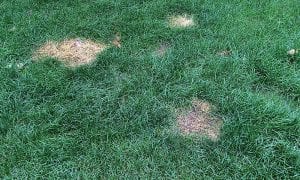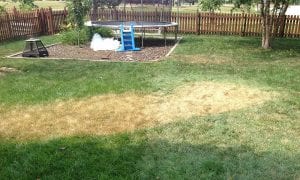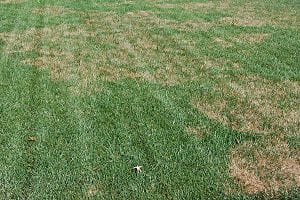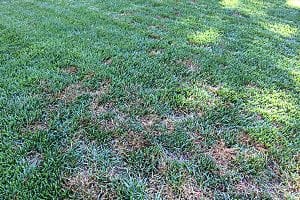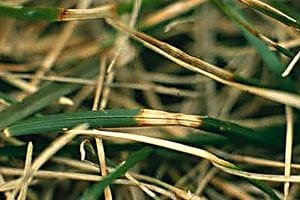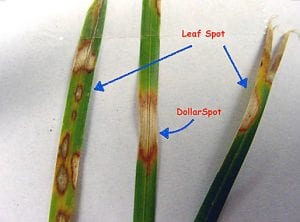What’s Causing Brown Patches On My Lawn?
Finding brown patches on the green lawn you work so hard to care for can be disappointing and distressing. Unfortunately, Midwest summers lead not only to increased use of the outdoor spaces around your home but also to summer lawn diseases that can devastate even the best-maintained lawns. Lawn diseases like brown spot, Pythium blight and dollar spot love warm, humid weather and thrive during the months of May through September. But they aren’t the only causes of brown patches in your lawn.
Learn more about all the situations that can leave brown patches in your lawn and what to do if your brown patches turn out to be one of the three most common fungal diseases that attack grass in the summer.
Non-Disease Causes of Brown Spots In Your Lawn
Not every brown area on your lawn is necessarily a disease. There are many things that can cause dead grass in the lawn. The key thing to do is to look at the area as a whole and also get down on your hands and knees and look for spots/marks/lesions on the leaf blade. Here are a few of the most common non-disease (abiotic) causes for brown patches in your lawn.
— Dull mower blades — Mowing your lawn with dull blades can shred the grass instead of cutting it cleanly and will damage the ends, causing them to die and turn brown.
— Animal urine — If you have dogs or other pets you may notice patches of brown lawn from the high nitrogen content of their urine.
— Play & Toys — Normal “wear and tear” on your lawn will not usually cause brown areas, but leaving a popular slip-n-slide or even a garden hose on your lawn during a hot summer day can leave bare spots.
— Chemicals — Gasoline from your lawnmower or another chemical spill can immediately kill the grass in your lawn, leaving a brown spot.
— Thatch Buildup — If your lawn isn’t fed, mowed or watered properly, your brown areas may be the result of thatch buildup. Your lawn can die from excessive thatch buildup, because the thatch prevents the grass plants from establishing deep roots, causing the plant to dry up and die during periods of heat and drought.
— Grubs — The May/June beetles, brown Masked chafer beetles, and Japanese beetles and many of the other beetles you see flying around in the summer start out as grubs buried in your lawn. Not only do the grubs eat your lawn, but the mammals like skunks, raccoons, and armadillos who eat grubs can also severely damage your lawn scrounging for their food.
— Weed Elimination — When you kill the weeds patches in your lawn or they die off naturally, they can leave dead spots that turn brown.
— Heat/Drought — This is probably the number one cause of brown areas that is not caused by a disease in a lawn. A lawn can go from green and moist to brown and dry in a few short days when the temperatures get above 80 F and the rains decrease in frequency.
If you’ve examined your brown patches and none of the above scenarios seem to fit, you may have a summer lawn disease. Learn more about how to identify fungus types, the most common lawn diseases and how to treat them.
How to Identify the Type of Fungus on Your Grass
The fungal organism is in the soil. Right now. Every soil, everywhere. There are a variety of reasons why your neighbor may have brown spots in their lawn from disease and you don’t. They may have a different species or variety of grass, different soil or moisture levels, or a different climate due to other natural or man-made landscapes.
There are three things to consider when trying to determine if a disease is causing the brown spots in your yard. It is very important to identify the specific type of disease. Correct identification is required before you can develop a treatment plan.
1. Identify the type of turfgrass
It’s important to first know the type of turf species you have because different types of grass are more susceptible to different diseases as shown in a University of Purdue Extension article on turf disease identification. In the Midwest, the two most common types of cool-season grasses used in home lawns are tall fescue and Kentucky bluegrass. The most common diseases we see are brown patch, dollar spot, and pythium blight. But other diseases do show up in our region from time to time.
2. Observe the pathogen at work
Once you know the type of grass, consider the pathogen component — the fungi itself and how it manifests on the turf. An experienced lawn care provider like Ryan Lawn & Tree can examine your brown patches and note the field patterns, symptoms, and signs in your lawn. Look at the dying grass but not just the dead grass to correctly identify the disease.
3. Consider the environment
The environment is the third component of identification and time of year must be considered. In the Midwest locations of Ryan Lawn & Tree, the warm temperatures, high humidity and soil composition including fertility and pH all play a role in the growth of various lawn diseases.
Three Most Common Diseases Causing Brown Patches on Lawn
Most of the summer lawn diseases that attack tall fescue and Kentucky bluegrass common in Midwest lawns prefer warm/hot and humid weather. The best conditions (or worst depending upon your point of view) for brown patch or Pythium disease growth are daytime temperatures between 80 and 95 degrees F, night-time temps around 65 to 70 degrees F, and high humidity. High summer temperatures combined with late afternoon showers every day in late May through July can be a recipe for disaster for lawns.
There are three types of fungal diseases that our RYAN Pros treat most often. Every tall fescue variety is susceptible to these three diseases — brown patch, dollar spot and Pythium blight. Learn how to differentiate between them and what you can do to get rid of these lawn diseases in your yard.
1. What Is Brown Patch Disease?
Brown patch is a common lawn disease found in all cool-season grasses in the U.S. caused by a fungus called Rhizoctonia solani. It appears as brownish-yellow, irregular circular patches that range from 6 inches to several feet in diameter. Brown patch begins to grow when temperatures reach 65 degrees F, but it grows fastest when temperatures reach 80 to 85 degrees F and there is high humidity.
The diseased leaves usually remain standing, and close examination shows tan, irregularly-shaped lesions on the leaves with a dark brown border.
2. What Is Pythium Blight Disease?
Caused by Pythium spp fungus, Pythium blight (sometimes called grease spot) has the potential to cause notable injury and death to turfgrass quickly. The disease normally appears suddenly as small, orange- to bronze-colored, circular spots. Spots may begin as small as ¾ inches but enlarge rapidly to 6 inches in diameter and larger.
Affected turfgrass dies rapidly, collapses, and seems oily and matted. White, cottony mycelia (a network of fine white filaments) may be visible early in the morning. The disease is driven by hot-wet weather, which correlates with increased stress on the turf. Blighting may also appear in streaks that follow the movement of water or machinery.
3. What Is Dollar Spot Disease?
Lawns affected with dollar spot begin as clusters of small, round straw-colored spots that are about the size of silver dollars but grow into larger, irregular patches. Individual blades for grass will have tan-buff color lesions that stretch across the entire width of the blade and will shrink in the middle forming an hourglass shape. Dollar Spot favors high humidity and temperatures ranging from 60 to 85 degrees F.
How to Get Rid of Brown Patch, Pythium Blight & Dollar Spot Fungus
Brown patch, Pythium blight and dollar spot diseases can damage or even kill your lawn. Pythium blight will kill areas of the lawn overnight. Brown patch and dollar spot, don’t usually kill large areas of the lawn but they certainly can kill large areas if the disease grows over a long enough period. Because these diseases thrive in warm, humid conditions, it’s important to treat the active disease with a fungicide that will control future problems. A correct diagnosis is essential because each of the diseases requires a specific fungicide.
Can My Lawn Grow Back After Brown Patch, Pythium Blight or Dollar Spot?
The only way the grass can recover from dollar spot and brown patch damage is for the grass to grow enough that the damaged blades are pushed up and mowed off, revealing new and undamaged blades below. Tall fescue and Kentucky bluegrass grass types grow more slowly as temperatures rise so it would take weeks or months for the grass to recover. And, it may require fall seeding to get the lawn back into shape. That’s why preventing damage before disease development is so important.
The best products for preventing and controlling lawn fungus are very expensive. Understanding turf diseases, their control, and when and how to apply them is very important. To get help with your lawn and protect it from fungus, request an estimate for disease control from a professional lawn care service.
When Should I Treat Brown Patch, Pythium or Other Diseases?
Does every yard have to be protected from fungus? It really depends upon the level of maintenance and expectations of the lawn. A mid-level lawn without an irrigation system may get some brown patch, and minor damage. If it gets bad enough, those damaged areas could be seeded in fall. You may want to consider treating your lawn disease if you:
-
- Seeded your yard in the spring. The young seedlings are more susceptible to fungus. Fungicide can protect baby seedlings.
- Have invested a lot in your lawn and love it very much.
- Have in-ground irrigation and water regularly in the summer to maintain good color and appearance.
- Seeded last fall. These lawns are usually thick and dense and the grass has not been through a hot summer phase, so it is typically more susceptible than mature lawns.
- Have a lawn seed that is a variety of Kentucky bluegrass that is notoriously susceptible to dollar spot and summer patch. RYAN Pros recommend using a fungicide until the variety can be switched over to other more resistant species or varieties.
RYAN Pros are experts at distinguishing one lawn disease from another — one of the keys to treating your lawn with the correct type and rate of fungicide.
Prevent Brown Patch, Pythium Blight & Dollar Spot — Contact Ryan Lawn & Tree
If you’re worried about losing your lawn permanently as you watch it turn brown, piece by piece, consider contacting the Pros at Ryan Lawn & Tree for a free inspection and quote. Ryan Lawn & Tree goes the extra mile to find and utilize only the best products that aren’t sold in big box stores. Why? Because they work better to control disease and save your beautiful lawn!
RYAN Pros study the latest university research to make sure they are using the best products at the best rate and times to achieve the best results for your lawn. Our educated, experienced lawn care experts will examine your brown patches and determine the cause, then give you a no-obligation quote for providing the appropriate preventive fungicide program. Get a Free Estimate or just a quick phone call to 855.216.2293 will get you started! Contact us today!

